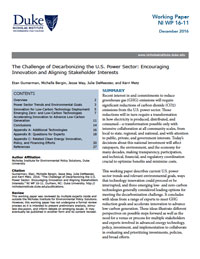Recent interest in and commitments to reduce greenhouse gas (GHG) emissions will require significant reductions of carbon dioxide (CO2) emissions from the U.S. power sector. Those reductions will in turn require a transformation in how electricity is produced, distributed, and consumed—a transformation possible only with intensive collaboration at all community scales, from local to state, regional, and national, and with attention to public, private, and government interests. Today’s decisions about this national investment will affect ratepayers, the environment, and the economy for many decades, making transparency, participation, and technical, financial, and regulatory coordination crucial to optimize benefits and minimize costs. This working paper describes current U.S. power sector trends and relevant environmental goals, ways that technology innovation could proceed or be interrupted, and three emerging low- and zero-carbon technologies generally considered leading options for meeting the decarbonization challenge. It concludes with ideas from a range of experts to meet GHG reduction goals and accelerate innovation to advance low-carbon generation. These ideas illustrate different perspectives on possible steps forward as well as the need for a venue or process for multiple stakeholders and experts involved in advanced energy technology, policy, investment, and implementation to collaborate in evaluating and prioritizing investments, policies, and broad efforts.
Nicholas Institute for Environmental Policy Solutions
Publisher

